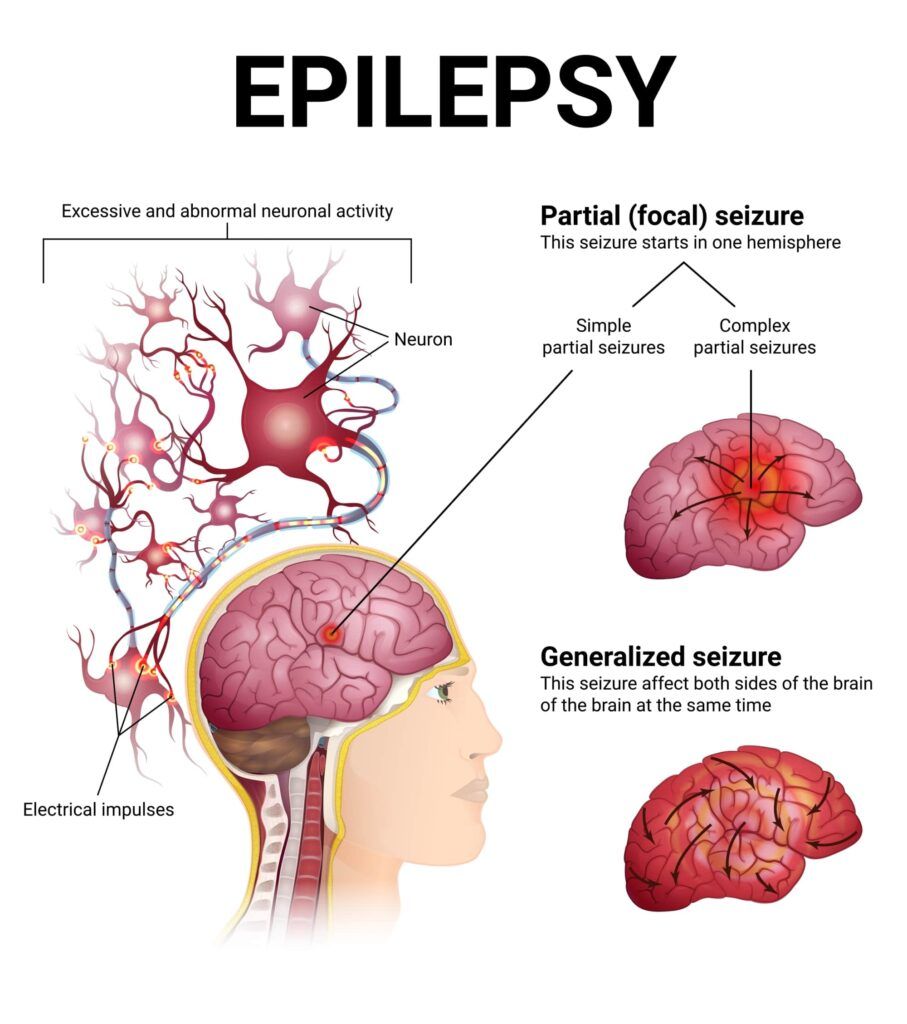Epilepsy is a neurological disorder that affects millions of people worldwide. It is characterized by abnormal electrical activity in the brain, which can cause seizures. There are many different types of seizures, and understanding the different types is crucial for accurate diagnosis and effective treatment. In this article, we’ll explore the various types of seizures that can occur in people with epilepsy, including focal and generalized seizures, as well as other less common types. By understanding the different types of seizures, individuals with epilepsy and their healthcare providers can work together to develop an individualized treatment plan and manage seizures effectively.
General Overview of Seizures

Seizures are sudden, uncontrollable surges of electrical activity in the brain that can cause a wide range of symptoms, depending on the type and severity of the seizure. During a seizure, the normal communication between brain cells is disrupted, causing abnormal behaviors, movements, sensations, and even loss of consciousness.
Seizures can manifest in many different ways, depending on which part of the brain is affected. They can affect a person’s motor functions, sensory experiences, cognitive abilities, and emotional responses. There are two main types of seizures: focal and generalized. Focal seizures occur in one specific area of the brain, while generalized seizures involve the entire brain.
Seizures can affect people of all ages, and they can be caused by many different factors, such as genetic mutations, head injuries, infections, stroke, and tumors. Some people with epilepsy may experience seizures frequently, while others may only experience occasional seizures or have seizures that are well-controlled with medication.
Focal (Partial) Seizures
Focal seizures, also known as partial seizures, occur when abnormal electrical activity is localized in one specific area of the brain. There are two types of focal seizures: simple partial and complex partial.
Simple Partial
Simple partial seizures don’t cause loss of consciousness, and symptoms can vary widely depending on which area of the brain is affected. Symptoms can include involuntary movements, altered senses (such as tingling or numbness), or emotional responses.
Complex Partial
Complex partial seizures can cause loss of consciousness and typically involve abnormal electrical activity in the temporal lobe of the brain. Symptoms can include auras (odd sensations or thoughts), involuntary movements, or altered consciousness.
Generalized Seizures
Generalized seizures involve abnormal electrical activity throughout the entire brain. There are several different types of generalized seizures, each with unique symptoms and characteristics. Here are some of the most common types:
- Absence seizures: These seizures are often called “petit mal” seizures and typically occur in children. They involve a sudden loss of consciousness and a blank stare, lasting from a few seconds up to half a minute. The person may not remember the seizure afterward.
- Myoclonic seizures: These seizures involve sudden, brief muscle jerks that can occur in any part of the body. The person may experience a single jerk or a series of jerks in quick succession.
- Clonic seizures: These seizures involve rhythmic, repeated jerking movements of the body, usually affecting the arms, face, and neck. The person may also experience loss of consciousness and convulsions.
- Tonic seizures: These seizures cause sudden, stiffening of the muscles, resulting in the person falling to the ground. The person may experience loss of consciousness and may not remember the seizure afterward.
- Atonic seizures: These seizures cause a sudden loss of muscle tone, causing the person to fall to the ground or slump in a chair. The person may experience loss of consciousness and may not remember the seizure afterward.
It’s important to note that generalized seizures can vary from person to person, and some people may experience multiple types of seizures. If you suspect that you or a loved one is experiencing seizures, it’s essential to speak with a healthcare provider for proper diagnosis and treatment.
Other Types of Seizures
In addition to focal seizures and generalized seizures, there are other types of seizures that can occur in people with epilepsy. Here are a few examples:
- Secondary generalized seizures: These seizures start as a focal seizure, but then spread and become generalized.
- Unclassified seizures: These seizures do not fit into the categories of focal or generalized seizures, and their origin may be unclear.
- Reflex seizures: These seizures are triggered by specific stimuli, such as flashing lights or sounds.
- Status epilepticus: This is a medical emergency that occurs when a seizure lasts for more than five minutes or when a person experiences multiple seizures without regaining consciousness between them.
- Psychogenic non-epileptic seizures (PNES): These are seizures that look similar to epilepsy seizures but are not caused by abnormal brain activity. They are usually related to psychological stress or trauma.
Treatment and Management
The treatment for epilepsy varies depending on the type and frequency of seizures. Medication is often the first line of treatment, but surgery and other interventions may be necessary in some cases. Here are some common methods used to manage seizures in people with epilepsy:
- Medications: Antiepileptic drugs (AEDs) are usually the first-line treatment for epilepsy. These medications work to reduce the abnormal electrical activity in the brain that causes seizures. There are many different types of AEDs, and the specific medication used will depend on the type of seizure and the individual’s overall health.
- Surgery: For some people with epilepsy, surgery may be an option to remove the area of the brain causing seizures. This is usually only considered when seizures cannot be controlled with medication or when the area of the brain causing seizures can be safely removed without causing significant damage.
- Vagus nerve stimulation (VNS): VNS is a therapy that involves implanting a device under the skin of the chest that sends electrical signals to the vagus nerve, which is connected to the brain. These signals can help reduce the frequency and intensity of seizures.
- Ketogenic diet: The ketogenic diet is a high-fat, low-carbohydrate diet that has been shown to be effective in reducing seizures in some people with epilepsy. The exact mechanism behind how the diet works is not fully understood, but it is thought to help increase the production of ketones, which can have a calming effect on the brain.
- Lifestyle modifications: Certain lifestyle modifications may also help manage seizures in people with epilepsy. These may include getting enough sleep, avoiding alcohol and drugs, and managing stress.
Additionally, medical marijuana has also been used to effectively treat epilepsy. Specifically, the cannabidiol (CBD) compound found in marijuana has been shown to have anticonvulsant effects, which may be beneficial in treating epilepsy. Here’s how medical marijuana is used to treat epilepsy:

- CBD oil: CBD oil is a concentrated form of CBD that is extracted from the marijuana plant. It is often taken orally and has been shown to reduce the frequency and severity of seizures in some people with epilepsy. However, it’s important to note that CBD oil can interact with other medications, and its use should be closely monitored by a healthcare provider.
- Medical marijuana strains: Some strains of marijuana contain higher levels of CBD than others, and these strains may be used to treat epilepsy. The tetrahydrocannabinol (THC) compound found in marijuana can also have anticonvulsant effects, but it can also cause psychoactive effects, such as a “high.” Strains with higher levels of CBD and lower levels of THC may be preferred for epilepsy treatment.
- Epidiolex: Epidiolex is a medication that contains purified CBD and is approved by the U.S. Food and Drug Administration (FDA) for the treatment of seizures associated with two rare forms of epilepsy: Lennox-Gastaut syndrome and Dravet syndrome.
It’s important to note that while medical marijuana may be effective in treating epilepsy for some people, it may not work for everyone. Additionally, the use of medical marijuana for epilepsy treatment should always be closely monitored by a healthcare provider, as it can interact with other medications and may have side effects. Overall, the treatment of epilepsy is individualized and may require a combination of different methods. People with epilepsy should work closely with a healthcare provider to develop a personalized treatment plan to manage their seizures.
In Conclusion
In conclusion, epilepsy is a complex neurological condition that can manifest in a variety of ways. There are two main types of seizures, focal and generalized, each with their own subtypes and unique characteristics. Treatment options for epilepsy vary depending on the type and severity of the seizures, but commonly include medications, surgery, and lifestyle modifications. Medical marijuana, specifically the CBD compound found in marijuana, has also been shown to have anticonvulsant effects and may be used in the treatment of epilepsy. It’s important for individuals with epilepsy to work closely with their healthcare provider to find the most effective treatment plan for their specific needs. With the proper management and care, many people with epilepsy are able to live full and productive lives.

Dr. Kashouty, a diplomate of the American Board of Psychiatry and Neurology (ABPN), practices general neurology with fellowship trained specialization in clinical neurophysiology. Dr. Kashouty finds the form and function of the nerves and muscles the most interesting part of neurology, which is what led him to specialize in neurophysiology with more emphasis on neuromuscular conditions. He treats all neurological diseases, but his main focus is to treat and manage headaches, movement disorders and neuromuscular diseases.




